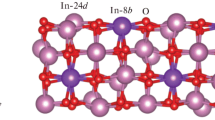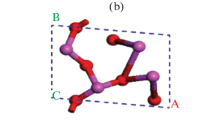Abstract
Based on the density functional theory, we investigated the electronic structures and magnetic properties of the oxygen adsorption on the defective cubic HfO2 (110) surface. The adsorption capacities of the perfect and defective surfaces follow in the sequence as: oxygen-deficient model >perfect surface >hafnium-deficient model. When the oxygen molecules adsorb on the nonmagnetic perfect HfO2 surface, the system has a local magnetic moment and the antiferromagnetic coupling is more stable. For the defective cubic HfO2 (110) surface, it is found that the oxygen vacancy is more easy to form than the hafnium vacancy by comparing the vacancy formation energy. And the hafnium vacancy could induce a large magnetic moment while the oxygen vacancy alone could not. After adsorption of the oxygen molecule, the nonmagnetic oxygen-deficient HfO2 model is transformed into the magnetic surface. On the contrary, the introduction of adsorbed oxygen molecule causes the magnetic moment of hafnium-deficient HfO2 surface to reduce. Additionally, if the oxygen molecules adsorb on the defective HfO2 (110) surface, the ferromagnetic coupling is energetically favorable.







Similar content being viewed by others
References
Kitchen, D., Richardella, A., Tang, J.M., et al.: Atom-by-atom substitution of Mn in GaAs and visualization of their hole-mediated interactions. Nature 442, 436–439 (2006)
Sato, K., Katayama-Yoshida, H.: Hyperfine interactions and magnetism of 3d transition-metal-impurities in II-VI and III-v compound-based diluted magnetic semiconductors. Hyperfine Interact. 136, 737–742 (2001)
Deka, S., Joy, P.A.: Synthesis and magnetic properties of Mn doped ZnO nanowires. Solid State Commun. 142, 190–194 (2007)
Wang, Y.Q., Yuan, S.L., Liu, L., et al.: Ferromagnetism in Fe-doped ZnO bulk samples. J. Magn. Magn. Mater. 320, 1423–1426 (2008)
Park, J.H., Kim, M.G., Jang, H.M., et al.: Co-metal clustering as the origin of ferromagnetism in Co-doped ZnO thin films. Appl. Phys. Lett. 84, 1338–1340 (2004)
Zhou, S., Potzger, K., Von Borany, J., et al.: Crystallographically oriented Co and Ni nanocrystals inside ZnO formed by ion implantation and postannealing. Phys. Rev. B 77, 035209 (2008)
Kaspar, T.C., Droubay, T., Heald, S.M., et al.: Hidden ferromagnetic secondary phases in cobalt-doped ZnO epitaxial thin films. Phys. Rev. B 77(R), 201303 (2008)
Venkatesan, M., Fitzgerald, C.B., Coey, J.M.D.: Thin films: unexpected magnetism in a dielectric oxide. Nature 430, 630–630 (2004)
Demkov, A.A.: Investigating alternative gate dielectrics: a theoretical approach. Phys. Status Solidi B 226, 57–67 (2001)
Zhao, X., Vanderbilt, D.: First-principles study of structural, vibrational, and lattice dielectric properties of hafnium oxide. Phys. Rev. B 65, 233106 (2002)
Hong, N.H.: Magnetism due to defects/oxygen vacancies in HfO2 thin films. Phys. Status Solidi (c) 4, 1270–1275 (2007)
Liu, X., Chen, Y., Wang, L., Peng, D.L.: Transition from paramagnetism to ferromagnetism in HfO2 nanorods. J. Appl. Phys. 113, 076102 (2013)
Ran, J., Yan, Z.: Observation of ferromagnetism in highly oxygen-deficient HfO2 films. J. Semicond. 30, 102002 (2009)
Pemmaraju, C.D., Sanvito, S.: Ferromagnetism driven by intrinsic point defects in HfO2. Phys. Rev. Lett. 94, 217205 (2005)
Weng, H., Dong, J.: Ferromagnetism in HfO2 induced by hole doping: first-principles calculations. Phys. Rev. B 73, 132410 (2006)
Beltrán, J., Muñoz, M., Hafner, J.: Structural, electronic and magnetic properties of the surfaces of tetragonal and cubic HfO2. New J. Phys. 10, 063031 (2008)
Wang, M., Feng, M., Lu, Y.: Possible origin of ferromagnetism in undoped monoclinic HfO2 film. Comput. Mater. Sci. 92, 120–126 (2014)
Chen, G.H., Hou, Z.F., Gong, X.G.: Structural and electronic properties of cubic HfO2 surfaces. Comp. Mater. Sci. 44, 46–52 (2008)
Kresse, G., Hafner, J.: Ab initio molecular dynamics for open-shell transition metals. Phys. Rev. B 48, 13115 (1993)
Kresse, G., Furthmüller, J.: Efficiency of ab-initio total energy calculations for metals and semiconductors using a plane-wave basis set. Comp. Mater. Sci. 6, 15–50 (1996)
Kresse, G., Furthmüller, J.: Efficient iterative schemes for ab initio total-energy calculations using a plane-wave basis set. Phys. Rev. B 54, 11169 (1996)
Perdew, J., Burke, K., Ernzerhof, M.: Generalized gradient approximation made simple. Phys. Rev. Lett. 77, 3865–3868 (1996)
Blöchl, P.E.: Projector augmented-wave method. Phys. Rev. B 50, 17953 (1994)
Kresse, G., Joubert, D.: From ultrasoft pseudopotentials to the projector augmented-wave method. Phys. Rev. B 59, 1758 (1999)
Janotti, A., Van de Walle, C.G.: Native point defects in ZnO. Phys. Rev. B 76, 165202 (2007)
Zhang, Y., Cao, E., Sun, L., et al.: Adsorption of NO on the SrFeO3 (001) surface: a DFT study. Comp. Mater. Sci. 102, 135–139 (2015)
Li, N., Sakidja, R., Ching, W.Y.: Ab initio study on the adsorption mechanism of oxygen on Cr2AlC (0001) surface. Appl. Surf. Sci. 315, 45–54 (2014)
Liu, X., Hu, J., Cheng, B., et al.: First-principles study of O2 adsorption on the LaFeO3 (010) surface. Sensor. Actuat. B-Chem. 139, 520–526 (2009)
Funding
This work was supported by the National Natural Science Foundation of China (Grant No. 11604234, 11404236, and 51602214), Special Funds of the National Natural Science Foundation of China (Grant No. 11447189), and Natural Science Foundation of Shanxi (Grant No. 2015021026 and 201601D202010).
Author information
Authors and Affiliations
Corresponding author
Rights and permissions
About this article
Cite this article
Jia, H., Liang, W., Zhou, M. et al. The Effect of Oxygen Adsorption for Vacancy-Induced d0 Magnetism in HfO2 (110) Surface. J Supercond Nov Magn 31, 3361–3370 (2018). https://doi.org/10.1007/s10948-018-4608-9
Received:
Accepted:
Published:
Issue Date:
DOI: https://doi.org/10.1007/s10948-018-4608-9




